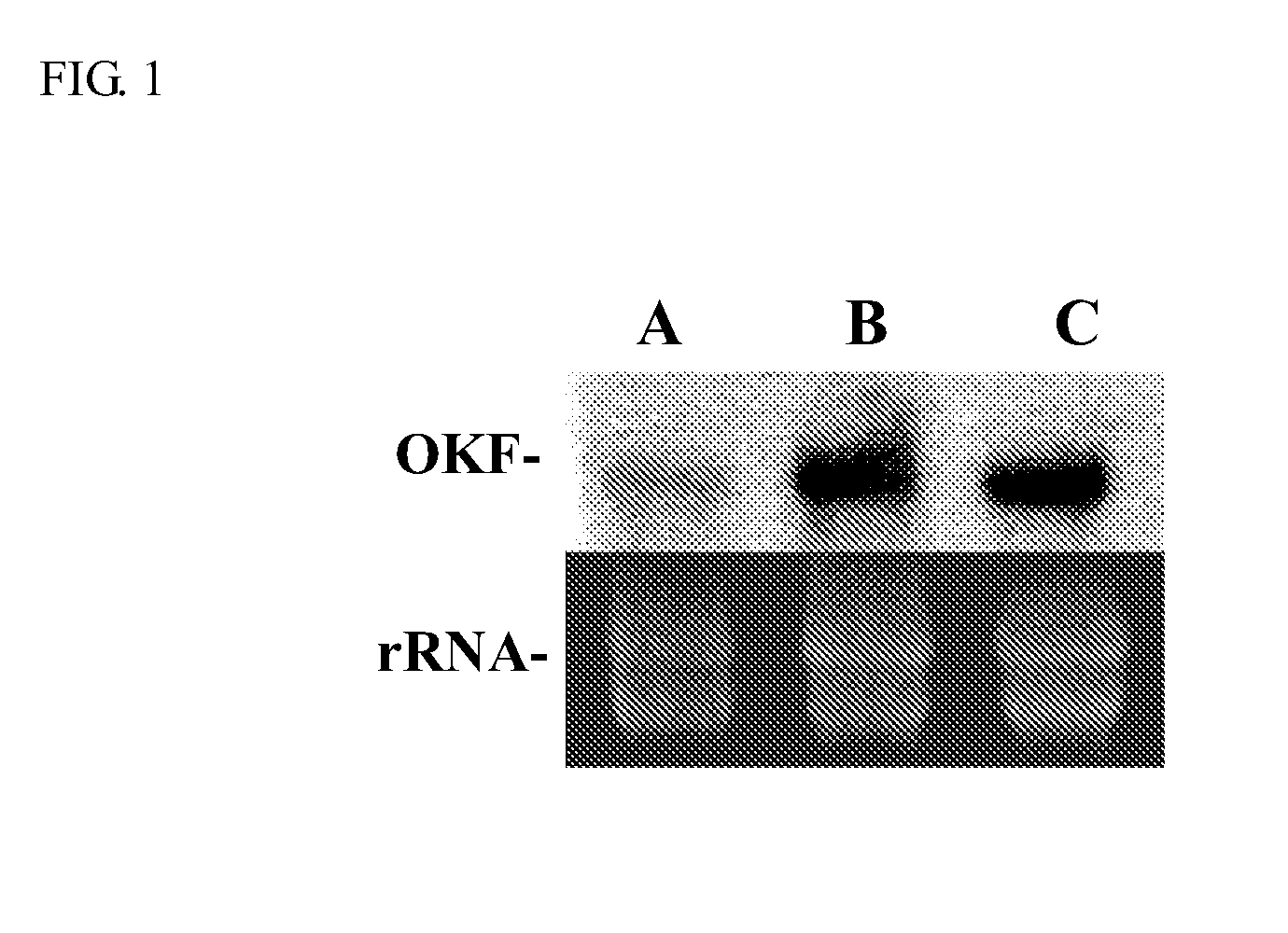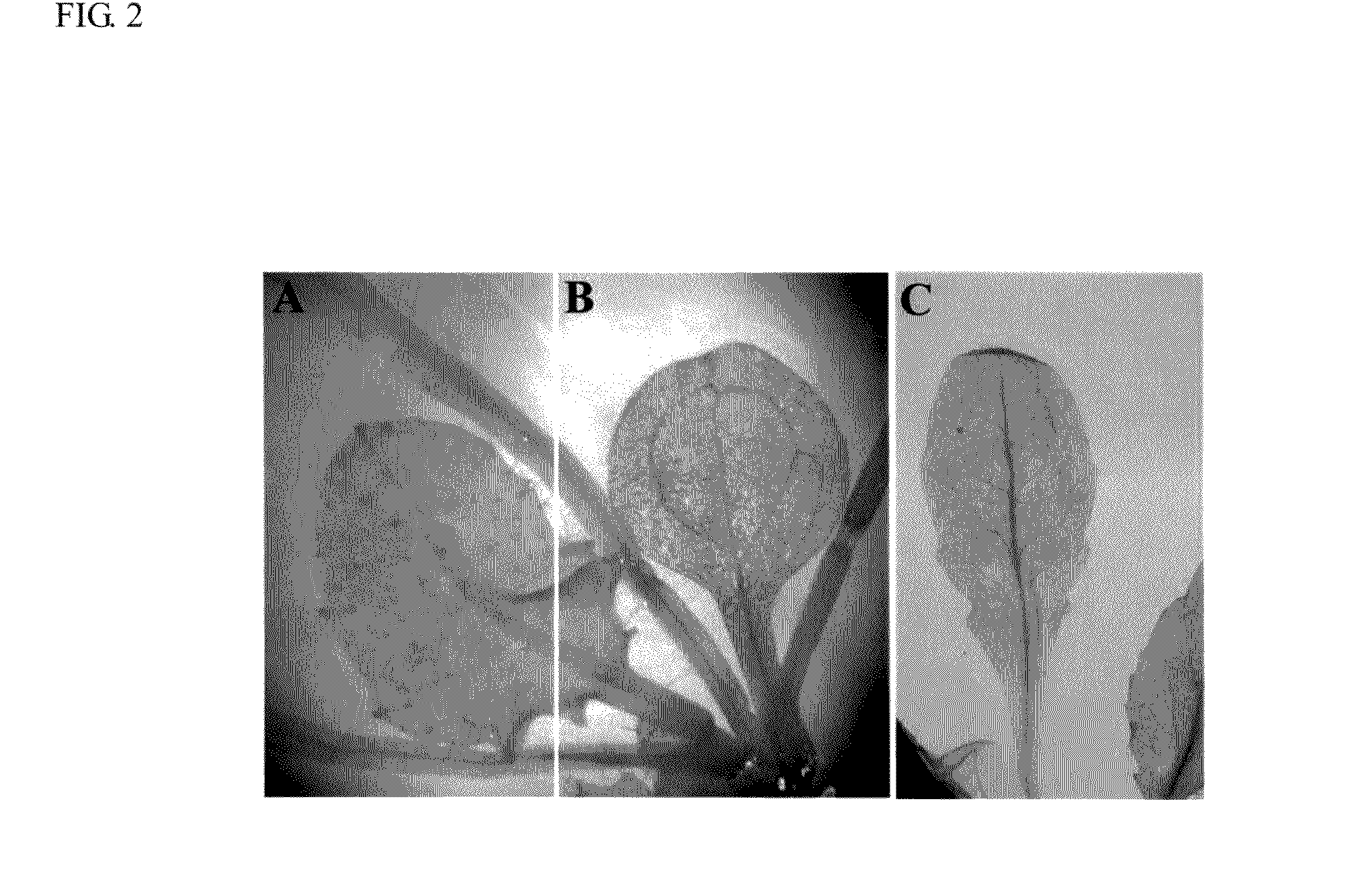Plant senescence-inducible promoter
a promoter and plant technology, applied in the field of plant senescence-inducible promoters, can solve the problems of tobacco mosaic virus 35s promoter not being suitable for tissue specific or senescence specific gene expression, and not being suitable for use in peptide sources, organic chemistry, biochemistry apparatus and processes
- Summary
- Abstract
- Description
- Claims
- Application Information
AI Technical Summary
Problems solved by technology
Method used
Image
Examples
example 1
RNA Extraction
[0015]Petals of Oncidium were put into a mortar and pestled with liquid nitrogen into powder. 0.1 g petal powder was then well mixed with 0.3 mL TRIZOL (Invitrogen BRL) in a beaker. The well mixed liquid was dispensed into a 2 mL microcentrifuge tube, and after standing at 4° C. for 5 minutes, ⅕ times volume of chloroform / isoamylacohol (24:1) was added and well mixed. After standing at 4° C. for 5 minutes, the mixture was centrifuged at 13000×g for 15 minutes at 4° C. The supernatant was then well mixed with 2 times volume of pre-cooling isopropanol. After standing for 10 minutes at room temperature, the mixture was centrifuged at 13000×g for 10 minutes at 4° C. The supernatant was discarded. The pellet was washed by 0.5 mL of 70% ethanol and then centrifuged at 13000×g for 5 minutes at 4° C. After discarding the supernatant, the microcentrifuge tube with the pellet was inverted to be air-dried for 20 minutes. 20 μL RNA lysis buffer (Protech Technology) was added and v...
example 2
mRNA Purification
[0016]Dynabeads mRNA purification kit of Dynal brand was used for mRNA purification. 100 μL binding buffer was added to 100 μL total RNA (1 μg / μL). After well mixing, the mixture was heated to 70° C. for 2 minutes and then placed on ice for later use. 200 μL of uniformly suspended Dynabeads containing oligoT25 was transferred into a new microcentrifuge tube and placed on the magnet. The supernatant was removed. The tube was removed from the magnet and the Dynabeads was re-suspended in 100 μL binding buffer. The microcentrifuge tube was placed back on the magnet. After removing the supernatant, the microcentrifuge tube was removed from the magnet and the Dynabeads was re-suspended in 100 μL binding buffer. The Dynabeads and mRNA sample were mixed thoroughly and placed at room temperature for hybridization for 3-5 minutes. After hybridization, the microcentrifuge tube was placed on the magnet for at least 1 minute. The supernatant was removed. The microcentrifuge tube...
example 3
Suppression Subtractive Hybridization (SSH)
[0017]Clontech PCR-select cDNA subtraction kit was used in the present invention. First-strand cDNA synthesis: 2-4 μL of Poly A+ RNA (2 μg) and 1 μL of cDNA synthesis primer (10 μM) were combined in a 0.5 mL PCR tube. The mixture were heated to 70° C. for 2 minutes and then cooled on ice for 2 minutes. 2 μL 5× first-Strand Buffer, 1 μL dNTP mix (10 mM each), and 1 μL AMV reverse transcriptase (20 unit / μL) were added and well mixed. The tube was incubated at 42° C. for 1.5 hours and then placed on ice immediately for promptly proceeding the second-strand cDNA synthesis.
[0018]Second-strand cDNA synthesis: 16 μL 5× second-strand buffer, 1.6 μL dNTP mix (10 mM each), and 4.0 μL 20× second-strand enzyme cocktail were mixed together and added to the product of first-strand cDNA synthesis. The contents were mixed thoroughly and incubated at 16° C. for 2 hours. 2 μL (6 units) T4 DNA polymerase was added. After 30 minutes of incubation at 16° C., 4 ...
PUM
| Property | Measurement | Unit |
|---|---|---|
| Gene expression profile | aaaaa | aaaaa |
Abstract
Description
Claims
Application Information
 Login to View More
Login to View More - R&D
- Intellectual Property
- Life Sciences
- Materials
- Tech Scout
- Unparalleled Data Quality
- Higher Quality Content
- 60% Fewer Hallucinations
Browse by: Latest US Patents, China's latest patents, Technical Efficacy Thesaurus, Application Domain, Technology Topic, Popular Technical Reports.
© 2025 PatSnap. All rights reserved.Legal|Privacy policy|Modern Slavery Act Transparency Statement|Sitemap|About US| Contact US: help@patsnap.com


